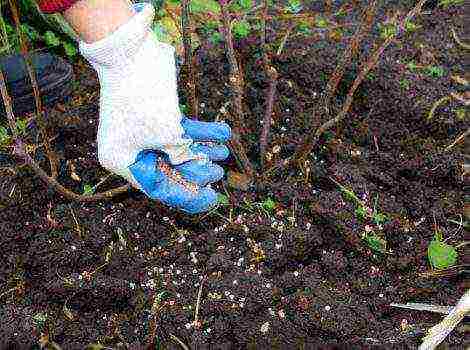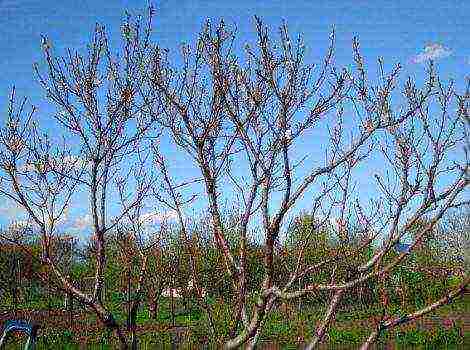Full description of the winter pear variety Belorusskaya Late
The pear is a fruit tree, more capricious and susceptible to adverse weather conditions than its related apple tree. In spite of this its fruits have earned recognition and honor among gardeners... This article provides a detailed description of the late Belarusian pear variety.
Description of the pear variety Belarusian late
Pear - a variety of Belarusian selection, is a medium-sized tree, attributed to the group of early-growing winter pears.
The crown is round, dense, formed by small, oblong-elliptical foliage... The leaf blades are smooth, light green in color. There are small denticles along the edge of the leaf.

Large skeletal branches articulate with the trunk almost at right angles. The ends of the branches go up. The geniculate shoots are moderately thickened and light brown in color with slight pubescence. They form a circle in cross section. The bark of the shoots is covered with many lentils.
Small buds, in turn, are not covered with pubescence and have a conical shape. Slightly bent away from the shoots.
Fruit formation occurs on the ringlets:
- Simple;
- Difficult.
The pear flower "Belorusskaya Late" is white with oval-shaped petals.
The possibility of harvesting the first harvest is already available at the 4th year of life. Fruit ripening usually occurs at the end of September. Pear yield is high... But the positive impressions of the abundance of crops are reduced by their frequency.
Fruit characteristics
The pears of the "Belorusskaya pozdnyaya" variety are not very large in size, reaching a mass of only 110 - 120 g. Upon reaching maturity, they have the correct wide pear-shaped shape... The fruits on the tree are predominantly the same size.
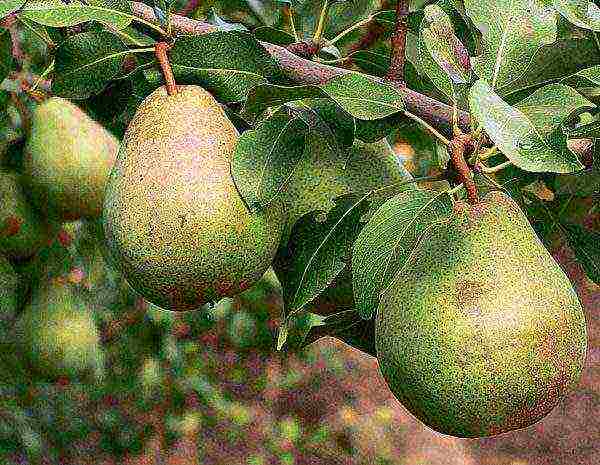
The rough, light-colored peel of pears is covered with light brown dots. The color at the time of removal from the tree is green, acquiring an orange-yellow color by the time of consumption. Cover color from red-brown to crimson shades.
Pears are juicy with medium density white pulp. They are distinguished by their oiliness and tenderness. Taste is rated from 4.2 to 4.4 points... The fruits are sweet with a slight sourness. Pear varieties "sit" on a shortened, even stalk.
Fruits taken from the tree in the last days of September can be stored until February, sometimes longer.
The variety "Belorusskaya Late" is considered self-fertile (self-pollinated), but in order to obtain a larger yield, it is recommended that there are "Butter" and "Bereloshitskaya" pears on the plot.
Breeding history, growing region
The pear tree of the variety "Belorusskaya pozdnyaya" belongs to the winter varieties of the selection of the Belarusian Research Institute of Fruit Growing... The variety was obtained by sowing seeds of uncontrolled pollination of pears "Good Louise".
The variety was entered into the State Register of Breeding Achievements Permitted for Breeding in the North-West and Central Regions.
Advantages and disadvantages of the variety
Gardeners include the positive qualities of this variety:
- Early maturity, that is, getting the first harvest just 3 or 4 years after planting;
- Long shelf life of fruits (in some cases, pears can be stored until April);
- High rate winter hardiness.
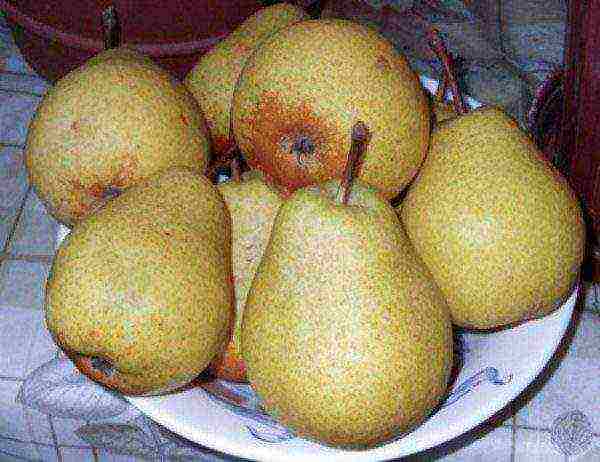
Disadvantages of a pear:
- Periodicity in fruiting;
- Exposure scab and fire blight;
- Shrinking fruit with large yields;
- Periodic pruning requirement due to the tendency to thicken the crown.
Landing rules
The most favorable time for disembarkation on the site is late spring.... After three days, as well as within fourteen days, after the snow cover has melted, the optimal time for planting a pear tree is. Landing in the autumn is possible: before the first frost, but after the fall of leaves.
When choosing a seedling, you need to pay attention to the condition of the planting material. A young tree should have elastic branches and a dense crown with healthy leaves.... The root system of the seedling should not have dry and torn roots.
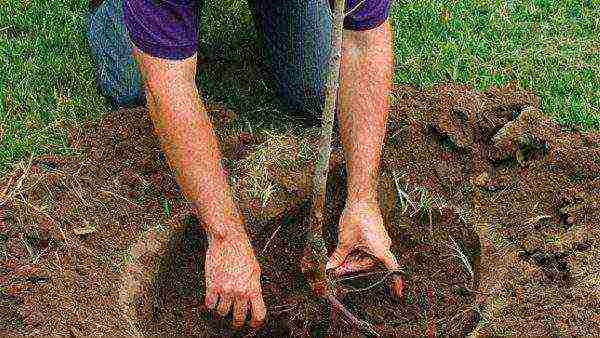
4x4 meters - the minimum size of a plot for a pear tree, which guarantees its normal development. In addition, the pear prefers well-lit places with fertile soils. The soil for planting a fruit tree should be well aerated and moderately moist. Planting Belorussian late on soils with regular stagnation of moisture or on too heavy clay soils is not allowed, which will lead to slow growth and development of the tree... Growing on sandy soils is accompanied by similar symptoms.
Landing technology:
- Before planting, it is necessary to pre-prepare the soil.... The most suitable substrate for a young seedling is a mineral-rich, loose soil.
- Landing pit for the "Belarusian late" pear should be up to 80 cm deep, and 100 cm in diameter. For seedlings with a closed root system, the planting pit is prepared according to the size of the earthen coma.
- Planting a seedling is carried out in dry, warm weather conditions... First of all, all leaves are removed from a young tree, and broken branches and torn roots are also cut off. Before planting, it is necessary to soak the root system of the seedling in water for 3 hours;
- A hole is being prepared in the center of the seatwhere the young tree is installed. In this case, it is necessary to carefully ensure that the root collar does not turn out to be buried in the soil - it is optimal to place it at a height of 7 cm from the ground level;
- After filling the pit with pre-prepared soil, the landing site is compacted;
- Watering after planting should be at least 30-40 liters per tree;
- After complete absorption of moisture, the trunk circle is mulched wood chips or fine crushed bark.
Growing conditions
Caring for the variety "Belorusskaya Late" is simple and consists in timely feeding, pruning, as well as treatment against diseases.
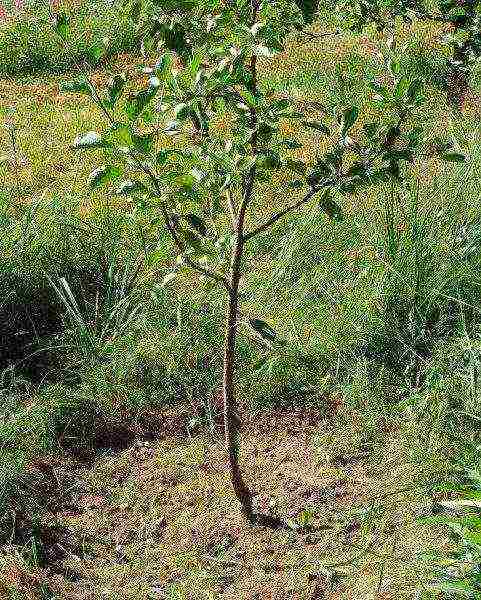
For the first few years, the pear tree trunk circle must be completely cleared of weeds., while digging up the soil is not worth it. Planting clover, red fescue and meadow bluegrass under a tree will enrich the soil with the necessary substances.
The pear of the Belarusian selection is drought-resistant, but in especially dry periods, a volume of water up to 70 liters per plant is applied under the tree twice a week.
Purpose of pruning young pear trees - the formation of the future crown of the tree. For this, the trunk is cut to a quarter of its total height, and from 3 to 4 strong branches are left on the trunk. Pruning of mature trees is done in the spring. In this case, all damaged, touching large branches are removed from the crown.
The first feeding is carried out only 2-3 years after planting. Fertilizers for pears can be applied by root and foliar methods... In the future, autumn and spring dressings are carried out on a regular basis, summer foliar feeding - if necessary.

Preparing a fruit tree for winter, despite its frost resistance, is necessary. It is recommended to tie the trunk with paper, and cover the trunk circles with a layer of wood shavings.
Harvesting and storage
Harvesting of fruits for storage is carried out 2-3 weeks before the average harvest date. At the same time, pears are removed from the branches by hand. When transferring fruits to containers, care must be taken: avoid blows and damage to the peel of the pear, detachment of the stalk.
The fruits are stored in containers or wooden boxes in well-ventilated rooms with temperatures ranging from +2 to +9 degrees. In a container, pears are stacked in no more than two layers. In this case, it is advisable to wrap each fruit in a separate newspaper sheet.
Features of this variety
Pear varieties "Belorusskaya Late" slope to a strong and rapid thickening of the crown, which negatively affects fruiting. To avoid this, it is necessary to carry out regular anti-aging pruning..
Pears that have not been stored are sent for processing - in jams, juices and preserves. Dried fruits are often made from Belarusian late pears.
Diseases and pests
The pear of the Belarusian selection is quite resistant to pests and diseases. Most often, it is affected by scab.
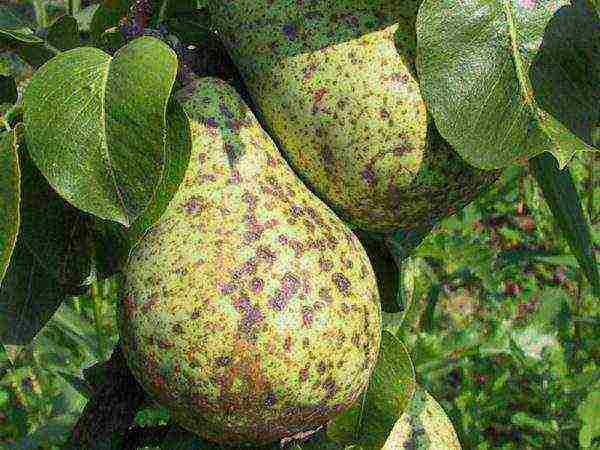
To protect the tree from insect pests, processing is carried out in three stages:
- Spraying with "Rogor-S" before flowering;
- 5% Bordeaux liquid solution is applied after flowering;
- During the growing season, spraying the tree with "Fitoverm" or "Aktara" is permissible;
- As a prophylaxis, a 5% urea solution is used.
Disease prevention:
- Before budding begins, the plant is sprayed with a 3% Bordeaux liquid. During budding period - "Tilt";
- After flowering, it is recommended to treat the trees with "Fundazol", and two weeks later - with a solution of urea;
- Processing with 1% Bordeaux liquid is allowed during fruit growth.
Due to its taste and long shelf life the variety "Belorusskaya Late" is firmly entrenched in the hearts of many gardeners. The small area occupied by the tree is complemented by significant harvests, which favorably distinguishes the variety from many others.

